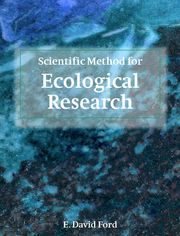Book contents
- Frontmatter
- Contents
- Preface
- Acknowledgements
- 1 Component processes of ecological research
- Introduction to Section I: Developing an analytical framework
- Introduction to Section II: Making a synthesis for scientific inference
- 10 Properties and domains of ecological concepts
- 11 Strategies of scientific research in ecology
- 12 Use of mathematical models for constructing explanations in ecology
- Introduction to Section III: Working in the research community
- Introduction to Section IV: Defining a methodology for ecological research
- Appendix: Suggestions for instructors
- References
- Glossary
- Author index
- Subject index
10 - Properties and domains of ecological concepts
Published online by Cambridge University Press: 08 January 2010
- Frontmatter
- Contents
- Preface
- Acknowledgements
- 1 Component processes of ecological research
- Introduction to Section I: Developing an analytical framework
- Introduction to Section II: Making a synthesis for scientific inference
- 10 Properties and domains of ecological concepts
- 11 Strategies of scientific research in ecology
- 12 Use of mathematical models for constructing explanations in ecology
- Introduction to Section III: Working in the research community
- Introduction to Section IV: Defining a methodology for ecological research
- Appendix: Suggestions for instructors
- References
- Glossary
- Author index
- Subject index
Summary
Summary
There are three types of ecological concept. Natural concepts define and classify measurable or observable entities in the ecological world. These are frequently common objects, such as organisms, or features of the environment, such as rainfall. Natural concepts such as chemical compositions can also be used to imply some property.
Functional concepts define a measurable process, interaction, or structure, such as photosynthesis, migration, or eutrophication, that applies to natural concepts. New functional concepts arise to describe newly understood structures or interactions in natural concepts and research into functional concepts is constantly used to refine the definition of existing natural concepts and their classifications.
Integrative concepts describe organization or properties of ecological systems that can not be measured as absolute quantities and must be explained by a theory. For example, ecosystems are theoretical constructions, and ecosystem theory describes general organizational and functional properties of ecosystems But we can measure only particular instances of ecosystems, and not all instances are identical or share all of the supposed properties in the same way. Similarly, resilience of an ecological system is not measurable directly but is inferred from species persistence when changes occur. The interest in such concepts lies not in the measurement, which is indirect or comparative, but in the underlying causes of why one species may be persistent and another not.
Functional concepts must be used to explain integrative concepts and the interest lies in how constant explanations are in different circumstances, e.g., can greater resilience always be explained in the same way?
- Type
- Chapter
- Information
- Scientific Method for Ecological Research , pp. 279 - 308Publisher: Cambridge University PressPrint publication year: 2000



